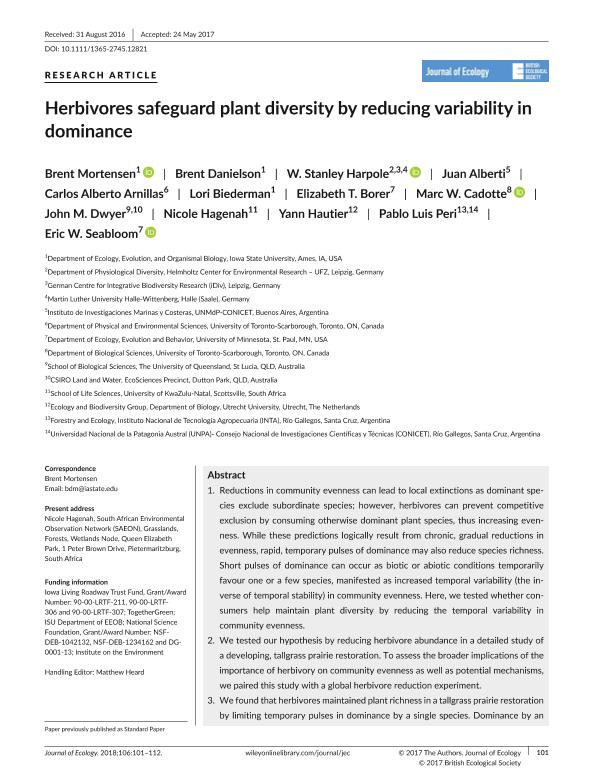Mostrar el registro sencillo del ítem
dc.contributor.author
Mortensen, Brent
dc.contributor.author
Danielson, Brent
dc.contributor.author
Stanley Harpole, W
dc.contributor.author
Alberti, Juan

dc.contributor.author
Arnillas, Carlos Alberto
dc.contributor.author
Biederman, Lori
dc.contributor.author
Borer, Elizabeth T
dc.contributor.author
Cadotte, Marc W
dc.contributor.author
Dwyer, John M.
dc.contributor.author
Hagenah, Nicole
dc.contributor.author
Hautier, Yann
dc.contributor.author
Peri, Pablo Luis

dc.contributor.author
Seabloom, Eric W.
dc.date.available
2019-11-26T18:53:09Z
dc.date.issued
2018-01
dc.identifier.citation
Mortensen, Brent; Danielson, Brent; Stanley Harpole, W; Alberti, Juan; Arnillas, Carlos Alberto; et al.; Herbivores safeguard plant diversity by reducing variability in dominance; Wiley Blackwell Publishing, Inc; Journal of Ecology; 106; 1; 1-2018; 101-112
dc.identifier.issn
0022-0477
dc.identifier.uri
http://hdl.handle.net/11336/90540
dc.description.abstract
Reductions in community evenness can lead to local extinctions as dominant species exclude subordinate species; however, herbivores can prevent competitiveexclusion by consuming otherwise dominant plant species, thus increasing evenness. While these predictions logically result from chronic, gradual reductions in evenness, rapid, temporary pulses of dominance may also reduce species richness. Short pulses of dominance can occur as biotic or abiotic conditions temporarily favour one or a few species, manifested as increased temporal variability (the inverse of temporal stability) in community evenness. Here, we tested whether consumers help maintain plant diversity by reducing the temporal variability in community evenness. We tested our hypothesis by reducing herbivore abundance in a detailed study of a developing, tallgrass prairie restoration. To assess the broader implications of the importance of herbivory on community evenness as well as potential mechanisms,we paired this study with a global herbivore reduction experiment. We found that herbivores maintained plant richness in a tallgrass prairie restoration by limiting temporary pulses in dominance by a single species. Dominance by an annual species in a single year was negatively associated with species richness, suggesting that short pulses of dominance may be sufficient to exclude subordinate species.The generality of this site-level relationship was supported by the global experiment in which inter-annual variability in evenness declined in the presence of vertebrate herbivores over timeframes ranging in length from 2 to 5 years, preventing declines in species richness. Furthermore, inter-annual variability of community evenness was also negatively associated with pre-treatment species richness.A loss or reduction of herbivores can destabilize plant communities by allowing brief periods of dominance by one or a few species, potentially triggering a feedback cycle of dominance and extinction. Such cycles may not occur immediately following the loss of herbivores, being delayed until conditions allow temporary periods of dominance by a subset of plant species.
dc.format
application/pdf
dc.language.iso
eng
dc.publisher
Wiley Blackwell Publishing, Inc

dc.rights
info:eu-repo/semantics/openAccess
dc.rights.uri
https://creativecommons.org/licenses/by-nc-sa/2.5/ar/
dc.subject
BIOMASS
dc.subject
CHAMAECRISTA FASCICULATA
dc.subject
DETERMINANTS OF PLANT COMMUNITY DIVERSITY AND STRUCTURE
dc.subject
LIGHT
dc.subject
NUTRIENT NETWORK
dc.subject.classification
Otras Agricultura, Silvicultura y Pesca

dc.subject.classification
Agricultura, Silvicultura y Pesca

dc.subject.classification
CIENCIAS AGRÍCOLAS

dc.title
Herbivores safeguard plant diversity by reducing variability in dominance
dc.type
info:eu-repo/semantics/article
dc.type
info:ar-repo/semantics/artículo
dc.type
info:eu-repo/semantics/publishedVersion
dc.date.updated
2019-10-21T18:23:17Z
dc.identifier.eissn
1365-2745
dc.journal.volume
106
dc.journal.number
1
dc.journal.pagination
101-112
dc.journal.pais
Reino Unido

dc.journal.ciudad
Londres
dc.description.fil
Fil: Mortensen, Brent. Iowa State University; Estados Unidos
dc.description.fil
Fil: Danielson, Brent. Iowa State University; Estados Unidos
dc.description.fil
Fil: Stanley Harpole, W. German Centre for Integrative Biodiversity Research (iDiv); Alemania
dc.description.fil
Fil: Alberti, Juan. Consejo Nacional de Investigaciones Científicas y Técnicas. Centro Científico Tecnológico Conicet - Mar del Plata. Instituto de Investigaciones Marinas y Costeras. Universidad Nacional de Mar del Plata. Facultad de Ciencias Exactas y Naturales. Instituto de Investigaciones Marinas y Costeras; Argentina
dc.description.fil
Fil: Arnillas, Carlos Alberto. University of Toronto-Scarborough; Canadá
dc.description.fil
Fil: Biederman, Lori. Iowa State University; Estados Unidos
dc.description.fil
Fil: Borer, Elizabeth T. University of Minnesota; Estados Unidos
dc.description.fil
Fil: Cadotte, Marc W. University of Toronto-Scarborough; Canadá
dc.description.fil
Fil: Dwyer, John M.. The University of Queensland; Australia
dc.description.fil
Fil: Hagenah, Nicole. University of KwaZulu-Natal; Sudáfrica
dc.description.fil
Fil: Hautier, Yann. Utrecht University; Países Bajos
dc.description.fil
Fil: Peri, Pablo Luis. Universidad Nacional de la Patagonia Austral; Argentina. Instituto Nacional de Tecnología Agropecuaria; Argentina. Consejo Nacional de Investigaciones Científicas y Técnicas; Argentina
dc.description.fil
Fil: Seabloom, Eric W.. University of Minnesota; Estados Unidos
dc.journal.title
Journal of Ecology

dc.relation.alternativeid
info:eu-repo/semantics/altIdentifier/url/https://besjournals.onlinelibrary.wiley.com/doi/full/10.1111/1365-2745.12821
dc.relation.alternativeid
info:eu-repo/semantics/altIdentifier/doi/http://dx.doi.org/10.1111/1365-2745.12821
Archivos asociados
